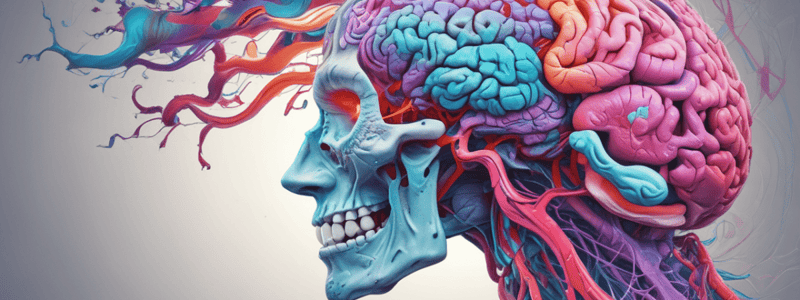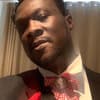Podcast
Questions and Answers
Which aspect of speech is not most noticeably affected in ataxic dysarthria?
Which aspect of speech is not most noticeably affected in ataxic dysarthria?
- Articulation
- Prosody
- Phonation (correct)
- Atypical stress patterns
How is ataxic dysarthria often described by listeners perceptually?
How is ataxic dysarthria often described by listeners perceptually?
- As a stuttering disorder
- As a speech fluency issue
- As a pseudo accent (correct)
- As a voice disorder
What function is attributed to the cerebellum in the context of speech production?
What function is attributed to the cerebellum in the context of speech production?
- Processing sensory information only
- Coordinating movement and planning only
- Integrating sensory information into movement execution (correct)
- Conveying information out of the cerebellum only
Which level(s) of speech production may manifest issues due to damage to the cerebellar control circuit?
Which level(s) of speech production may manifest issues due to damage to the cerebellar control circuit?
What are some common speech characteristics associated with ataxic dysarthria?
What are some common speech characteristics associated with ataxic dysarthria?
Apart from motor activities, what other functions are attributed to the cerebellum?
Apart from motor activities, what other functions are attributed to the cerebellum?
What is the most common cause of Upper Motor Neuron (UMN) damage?
What is the most common cause of Upper Motor Neuron (UMN) damage?
Which of the following is a clinical speech finding associated with UMN damage?
Which of the following is a clinical speech finding associated with UMN damage?
What is a common patient complaint associated with Upper Motor Neuron (UMN) damage?
What is a common patient complaint associated with Upper Motor Neuron (UMN) damage?
Which condition is not listed as an etiology of Mixed Dysarthria in the text?
Which condition is not listed as an etiology of Mixed Dysarthria in the text?
What symptom is characteristic of lesions in the indirect activation pathway?
What symptom is characteristic of lesions in the indirect activation pathway?
Which disease is not mentioned as an etiology of Upper Motor Neuron (UMN) damage?
Which disease is not mentioned as an etiology of Upper Motor Neuron (UMN) damage?
What is the primary role of the cerebellum in speech control?
What is the primary role of the cerebellum in speech control?
Which of the following is NOT a movement deficit associated with damage to the cerebellum?
Which of the following is NOT a movement deficit associated with damage to the cerebellum?
What characterizes ataxic dysarthria in terms of movement?
What characterizes ataxic dysarthria in terms of movement?
What is dysmetria?
What is dysmetria?
What type of dysarthria is characterized by overshooting movements and a lack of coordination?
What type of dysarthria is characterized by overshooting movements and a lack of coordination?
Which of the following is a common symptom of ataxic dysarthria?
Which of the following is a common symptom of ataxic dysarthria?
What does the cerebellum influence in speech control through its connections to the extrapyramidal system?
What does the cerebellum influence in speech control through its connections to the extrapyramidal system?
What does the cerebellum not control in speech?
What does the cerebellum not control in speech?
Which term best describes the articulation movements in ataxic dysarthria?
Which term best describes the articulation movements in ataxic dysarthria?
Ataxic dysarthria is the most common type of motor speech disorder.
Ataxic dysarthria is the most common type of motor speech disorder.
Damage to the cerebellum can manifest in any level of speech production.
Damage to the cerebellum can manifest in any level of speech production.
Ataxic dysarthria is characterized by accurate force and range of motion in speech movements.
Ataxic dysarthria is characterized by accurate force and range of motion in speech movements.
Perceptually, ataxic dysarthria is often described as a lack of accents by the listener.
Perceptually, ataxic dysarthria is often described as a lack of accents by the listener.
The primary function of the cerebellum is to process visual information during speech production.
The primary function of the cerebellum is to process visual information during speech production.
Ataxic dysarthria may present with atypical stress patterns in speech.
Ataxic dysarthria may present with atypical stress patterns in speech.
The cerebellum is responsible for the movements in speech production.
The cerebellum is responsible for the movements in speech production.
Cerebellar ataxia may lead to challenges with motor learning.
Cerebellar ataxia may lead to challenges with motor learning.
Ataxic dysarthria is characterized by undershooting movements in speech.
Ataxic dysarthria is characterized by undershooting movements in speech.
Dysmetria refers to a lack of coordination of movement with overshoot or undershoot of intended position.
Dysmetria refers to a lack of coordination of movement with overshoot or undershoot of intended position.
Ataxic dysarthria may present with typical stress patterns in speech.
Ataxic dysarthria may present with typical stress patterns in speech.
Unilateral Upper Motor Neuron Dysarthria is considered the most severe form of dysarthria.
Unilateral Upper Motor Neuron Dysarthria is considered the most severe form of dysarthria.
Lesions in the indirect activation pathway are characteristic of ataxic dysarthria.
Lesions in the indirect activation pathway are characteristic of ataxic dysarthria.
Damage to the cerebellum can manifest in any level of speech production.
Damage to the cerebellum can manifest in any level of speech production.
Ataxic dysarthria is the most common type of motor speech disorder.
Ataxic dysarthria is the most common type of motor speech disorder.
The cerebellum influences speech control primarily through connections to the direct activation pathway.
The cerebellum influences speech control primarily through connections to the direct activation pathway.
Lesions in the direct activation pathways can result in hyperactive stretch reflexes.
Lesions in the direct activation pathways can result in hyperactive stretch reflexes.
UMN damage is commonly caused by degenerative, inflammatory, and toxic-metabolic diseases.
UMN damage is commonly caused by degenerative, inflammatory, and toxic-metabolic diseases.
Trauma is not a potential cause of UMN damage.
Trauma is not a potential cause of UMN damage.
In ataxic dysarthria, phonation is often characterized by a decreased loudness.
In ataxic dysarthria, phonation is often characterized by a decreased loudness.
Spasticity is a common symptom of lesions in the indirect activation pathway.
Spasticity is a common symptom of lesions in the indirect activation pathway.
Mixed Dysarthria is characterized by any one of the components predominating over others.
Mixed Dysarthria is characterized by any one of the components predominating over others.
________ processes sensory information from all over the body and integrates that information into execution of a movement
________ processes sensory information from all over the body and integrates that information into execution of a movement
Which structure is responsible for coordinating movement, planning motor activities, learning and remembering physical skills, and some cognitive abilities?
Which structure is responsible for coordinating movement, planning motor activities, learning and remembering physical skills, and some cognitive abilities?
The cerebellum has a dual ability to coordinate and modify planned and ongoing speech movements by the cerebellum.
The cerebellum has a dual ability to coordinate and modify planned and ongoing speech movements by the cerebellum.
You are assessing an individual with suspected dysarthria. The demonstrate difficulty coordinating voluntary movements, and coordinating the force of movements. They also have a broad-based gait and hypotonia of muscles. Which dysarthria type is likely?
You are assessing an individual with suspected dysarthria. The demonstrate difficulty coordinating voluntary movements, and coordinating the force of movements. They also have a broad-based gait and hypotonia of muscles. Which dysarthria type is likely?
An individual with Ataxic dysarthria will have a normal oral mechanism exam.
An individual with Ataxic dysarthria will have a normal oral mechanism exam.
Which of the follow assessment tasks may be irregular for individuals with ataxic dysarthria?
Which of the follow assessment tasks may be irregular for individuals with ataxic dysarthria?
Which is the most mild form of dysarthria?
Which is the most mild form of dysarthria?
Which of the following is not a result of lesions in the direct activation pathway?
Which of the following is not a result of lesions in the direct activation pathway?
Which of the following is not a result of lesions in the indirect pathway
Which of the following is not a result of lesions in the indirect pathway
What is the most prominent perceptual speech characteristic of unilateral upper motor neuron dysarthria?
What is the most prominent perceptual speech characteristic of unilateral upper motor neuron dysarthria?
A patient complains that their speech sounds slurred, their lower face is drooping, drooling, and mild swallowing difficulty. Which dysarthria type is most likely?
A patient complains that their speech sounds slurred, their lower face is drooping, drooling, and mild swallowing difficulty. Which dysarthria type is most likely?
Which dysarthria type accounts for 27% of all dysarthrias?
Which dysarthria type accounts for 27% of all dysarthrias?
Flashcards are hidden until you start studying





